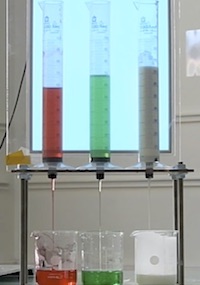- Share
- Share on Facebook
- Share on X
- Share on LinkedIn

Solid or liquid ?
We are familiar with the changes of state that simple bodies can undergo as a result of a change in temperature (e.g. ice melting) or those related to a chemical transformation (e.g. egg white coagulating).
Based on the intuitive and familiar definitions of a solid and a liquid (how do we distinguish between them?), we discover that certain materials called "complex fluids" can exhibit both types of behavior, without involving any phase change phenomenon. We realize that the behavior of these complex fluids depends on the mechanical stress (strain rate, force) through several visual experiments.
By looking at their composition, we discover the link between their microscopic structure (suspensions, elastic polymer solutions...) and their macroscopic behavior, as well as the interesting properties that these behaviors confer to everyday products (biological fluids, food, cosmetic or industrial products).
Fluids with variable viscosity
Simple fluids (called Newtonian) have a viscosity that is independent of the flow or the forces to which they are subjected: the flow velocity is simply proportional to the force applied. Thus, honey being more viscous than water, it flows more slowly.
Let us observe the emptying of three containers containing three fluids with different behaviors. Which of these three "liquid hourglasses" will empty first? The order of arrival of this race thwarts the prognosis and allows us to wonder about
- the mechanisms of emptying a viscous fluid (notions of hydrostatic pressure and viscous friction)
- the microscopic origin of the different behaviors observed in the three hourglasses
In parallel, a more direct measurement of the variation of viscosity of the various fluids according to the applied force can be carried out by measuring the speed of displacement of an object subjected to a constant force in the fluid: one thus directly highlights the rheofluidifying or rheo-thickening behavior of certain liquids.
Contact
Salime RAFAI
Office 330
salima.rafai univ-grenoble-alpes.fr (salima[dot]rafai[at]univ-grenoble-alpes[dot]fr)
univ-grenoble-alpes.fr (salima[dot]rafai[at]univ-grenoble-alpes[dot]fr)
Solid or liquid

Fluids with variable viscosity

- Share
- Share on Facebook
- Share on X
- Share on LinkedIn